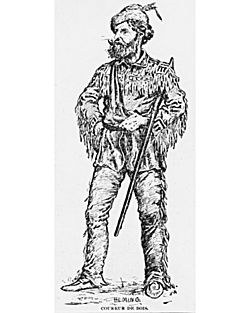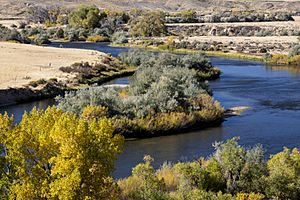Jacques La Ramee facts for kids
Quick facts for kids
Jacques La Ramée
|
|
|---|---|

Jacques La Ramée was a coureur des bois, believed similar in appearance to this woodcut by artist Arthur Heming
|
|
| Born | June 8, 1784 |
| Died | 1821 (aged 37) |
| Nationality | Canadian |
| Other names | Jacques Laramée, La Ramie, La Rami, La Remy, or Laramie |
| Occupation | voyageur, frontiersman, coureur des bois, trapper, fur trader, hunter, explorer |
| Employer | North West Company, La Ramée family free trapping company |
| Parent(s) | Joseph Fissiau dit Laramée and Jeanne Mondou |
Jacques La Ramée (born June 8, 1784 – died 1821) was a brave French-Canadian and Métis explorer. He was also a frontiersman, trapper, and fur trader. La Ramée lived in what is now the state of Wyoming. He settled there around 1815.
His name is spelled in many ways, like La Ramee, Laramée, or Laramie. Jacques La Ramée is known for exploring the Laramie River in Wyoming and Colorado. The city of Laramie, Wyoming was later named after him.
Contents
Early Life of Jacques La Ramée
Jacques La Ramée was born on June 8, 1784. His birthplace was Québec, in what was then British Canada. His parents were Joseph Fissiau dit Laramée and Jeanne Mondou. Some people describe him as Métis, meaning he had both French and First Nation heritage.
Records from the North West Company mention two Laramée brothers, Jacques and Joseph. Another person named Francois Laramée worked as a canoe man in the western United States. He might have been related to Jacques. Francois had sons who also traveled west into Wyoming and Idaho. One of these sons was likely the Jacques La Ramée who gave his name to the Laramie River.

A writer named Susan Bordeaux Bettelyoun said her father, James Bordeaux, was La Ramée's cousin. She claimed her father found La Ramée's body after he died.
A Fur Trader and Explorer
Jacques La Ramée worked as a voyageur and fur trader. He worked for the North West Company and John Jacob Astor's American Fur Company. These companies often competed, sometimes even violently. In 1821, the two rival companies joined together.
La Ramée was known for being peaceful and honest. In 1815, he gathered a group of independent trappers. They wanted to find the start of the North Platte River in Wyoming. La Ramée and his group became friends with many Native American tribes. They would trade animal furs for European goods.
This led to the first "free trapper rendezvous" in Wyoming. At these meetings, trappers could trade their furs without needing a big company. Free trappers would meet every May along the North Platte River. La Ramée was a leader among them. He helped decide where each trapper would hunt for furs.
LaRamée's Rendezvous Meetings
In 1815, La Ramée organized a meeting for free trappers. This meeting happened where the North Platte and Laramie rivers meet. Later, other fur-trading companies also held their yearly meetings here. For five years, more and more trappers and traders came to these events. A trade market grew, and new routes for supplies were made.
After the May rendezvous, traders would send furs to Saint Louis, Missouri. They used special boats called bullboats on the Missouri River. Supplies would come back by keelboat or bullboat. La Ramée gave supplies to the free trappers. He also assigned them specific areas to trap in for the next season.
The Mystery of His Death
In 1820, La Ramée went off to trap along the Laramie River. He was never seen alive again. When he did not show up for the next rendezvous, people started looking for him. No one knows for sure how he died.
Some stories say he slipped on ice and fell into the Laramie River. Others say his body was found in a small cabin. Another story claims he was found "stuffed under a beaver dam." Some people thought rival trappers or traders killed him and threw him into the river. One person, Pierre Lesperance, said Arapaho warriors attacked La Ramée's camp. However, the Arapaho people strongly denied this.
La Ramée's Legacy
Many places in Wyoming are named after Jacques La Ramée. His name was changed to "Laramie" in English. These places include the Laramie River and the city of Laramie, Wyoming. Also, Fort Laramie, Laramie Peak, and Laramie County carry his name.
In Popular Culture
The 1974 book Centennial by James A. Michener features a character named "Pasquinel." He was a French Métis coureur des bois from Montreal. Pasquinel was shown as an early mountain man and trapper in 1795 Colorado. This area was then part of the Spanish Upper Louisiana Territory.
NBC made a mini-series based on the book, also called Centennial. It aired in 1978-1979. Actor Robert Conrad played Pasquinel. Many believe that the character Pasquinel was based on Jacques La Ramée.
See also
 In Spanish: Jacques La Ramée para niños
In Spanish: Jacques La Ramée para niños

